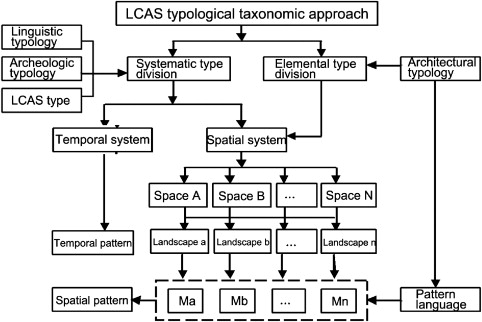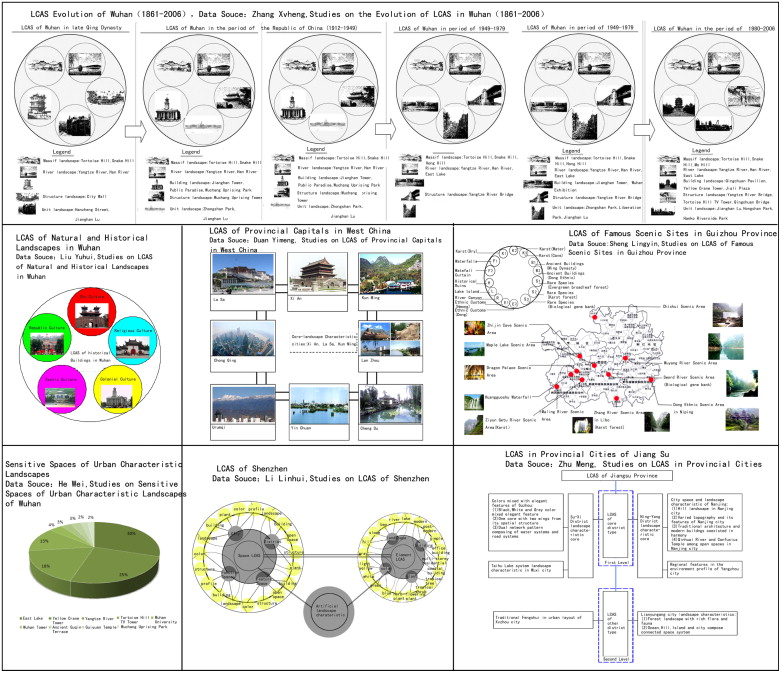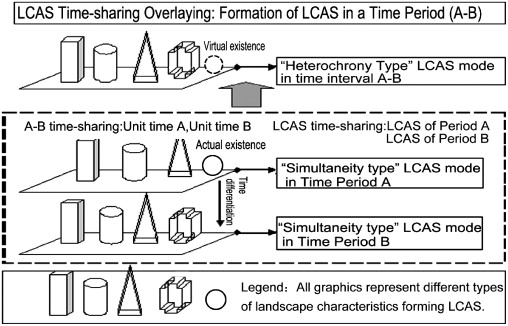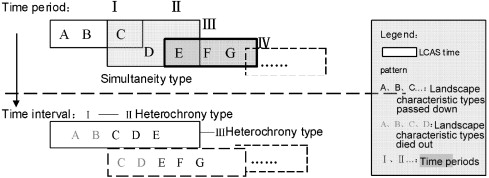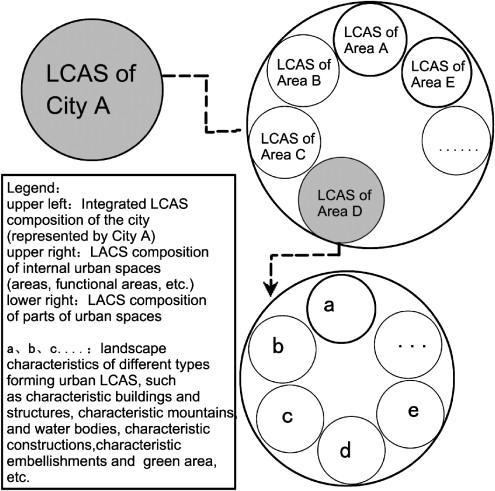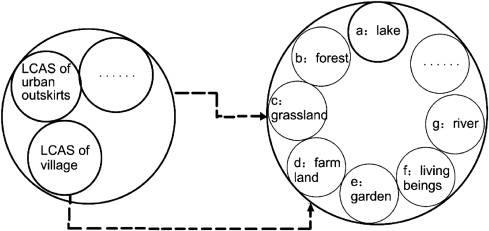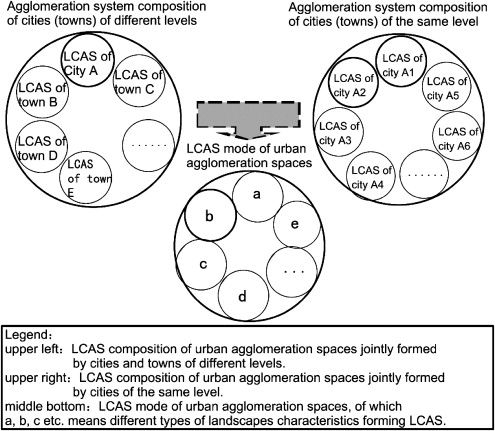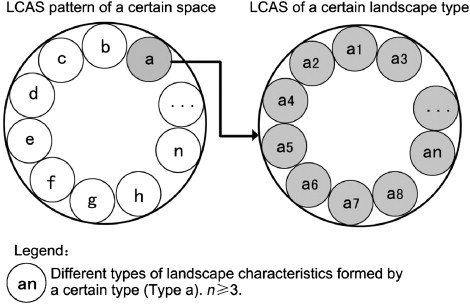Abstract
The paper presents means and models of city-landscape characteristic structure construction on the aspect of landscape aesthetics subjects, which is called the landscape characteristic aesthetic structure and in short as LCAS. In this paper, the steps of LCAS research are as follows:
Describes the concepts of the landscape characteristic aesthetic structure (LCAS), and expounds the LCAS properties: systematic quality, temporal and spatial quality, and virtual existence.
Learns from typology research methods, discusses the elements and types needed in a landscape characteristic aesthetic system, and constructs research method for LCAS pattern. As for the temporal dimension, the dynamic evolution and interaction expressed in LCAS between the “tradition” and “modernity” landscapes conflict. As for the spatial dimension, this paper explores the LCAS patterns in macroscopic scope of city group, the middle scope of single cities and the microcosmic scope of urban spaces with questionnaires and examples research.
Uses pattern language to express different LCAS types in the temporal and spatial system.
We develop the patterns of various LCAS types with graphical patterned representation, as well as construct the LCAS research method and theory which is based on the general peoples aesthetic standards and sensibilities to build city characteristics and urban landscapes as a guidance.
Keywords
Landscape characteristic aesthetic structure ; LCAS ; Urban ; Space ; Pattern
1. Introduction
1.1. Background
In the era of globalization, cities are now experiencing a “characteristic crisis”. The tension between “tradition” and “modernity” has generated two harmful trends in city construction and urban planning. Firstly, in urban planning and design methodology, various kinds of outstanding theories and methods are borrowed and referred to frequently yet are not appropriately adapted to local conditions. Moreover, such designs fail to fulfil aesthetic requirements of citizens. Thus, these designs might be considered “designer-oriented”. The “designer”, with obscured design languages, acts as the only creator who decides on the characteristics of the cities and their landscapes, preventing citizens from appreciating their cities and landscapes. Thus, citizens experience less “characteristic identification”. These problems result in the “characteristic crisis” in cities where similarities among landscapes could be found.
Based on the aforementioned social context and demands, this paper tries to use the landscape characteristic aesthetic structure (LCAS) to analyze dialectically the interactive relationships among urban construction, cities, and aesthetic subjects. By taking the perspectives of citizens, who are key aesthetic subjects of urban landscapes, this paper examines the viewpoints employed in investigating and understanding cities and landscapes. Finally, this paper constructs an LCAS by means of aesthetic sensibilities of the citizens for adaptable urban construction.
1.2. Definitions
1.2.1. Landscape characteristics
“Landscape characteristic refers to the unique aesthetic features that can distinguish one scene from another in certain time and space ranges. It is the expression of the unique aesthetic features of the landscapes” (Yu, 2008 ). Landscape characteristic is the result of heterogeneous aesthetics, which, in turn, express the types of landscape characteristics. For example, the Yellow Crane Tower in Wuhan, China, is one of the characteristic landscapes of this city. Its shape, colour and volume, as well as the materials used from the heterogeneous aesthetic features, which, in turn, exhibit the landscape characteristics.
1.2.2. Landscape characteristic aesthetic structure (LCAS)
“Landscape is a kind of objective existence. A scene, whether natural or human, shall not be taken as landscape if it cannot be or will not be understood by people” (Yu, 1997 ). Landscape aestheticism is a positive reaction that occurs in the dialogue between the viewers and the landscape. A single object might trigger different aesthetic responses from different viewers, similar to the famous western saying, “There are a thousand Hamlets in a thousand peoples eyes.” As such, this study organizes landscapes into an aesthetic group in order to lay aside individual characteristics of landscapes and determine the generalities of the group accordingly. The generalities resulted are used to construct the LCAS. Therefore, LCAS is the “composition relations and methods of the types of the landscape characteristics constructed in aesthetic activities by aesthetic subjects in the aesthetic system of specific time and space by means of the functions of aesthetic psychological structure of citizens” (Yu, 2006 ). LCAS represents the methods and patterns used to construct the landscape characteristics in time and space taking the perspective of viewers.
1.3. Features of LCAS
The basic features of LCAS include its systematic, temporal, spatial and hierarchical qualities.
1.3.1. Systematic quality of LCAS
According to the Systems Theory, a system refers to any entity assembled by individual parts. Such a system can be as tiny as an atom or as large as the universe.
LCAS is also regarded as a system composed of aesthetic subjects, time and space ranges, and landscape objects of aesthetic activities. The kinds and types of landscapes may vary according to different temporal and spatial systems. An LCAS system itself may also be formed by subsystems featured by different temporal, spatial and landscape types.
If an LCAS system is taken as M and its subsystems as M1, M2, and M3 to Mn , M could be expressed as {M1, M2, M3, ……, Mn }. In the formula, the braces refer to the connection of all subsystems as a united and integrated system.
1.3.2. Temporal and spatial quality of LCAS
“According to philosophers, time and space are the basic attributes for the existence of a moving object. Time represents the sequence and continuity of the objects movement and space represents the extensibility and flexibility of the objects existence” (Yang, 1997 ). Thus, the landscape, when understood as a “moving object”, also presents its existence and evolution in dynamic temporal and spatial systems. The historical and territorial features of landscapes are represented from temporal and spatial dimensions, respectively.
Temporal dimension : A landscape itself is an artwork of time, which has experienced constant evolution over the course of human history. Landscapes in the same region represent different external appearances and aesthetic sensibilities derived from different historical periods. Therefore, the discrepancies over time form the basis for the territorial features of LCAS. The historical feature of such evolution and discrepancies of landscapes over time is important in investigating the dynamic evolution of LCAS.
Spatial dimension : The characteristic discrepancies of LCAS are represented in territorial units at different levels. Territorial units are the spatial areas measured by different scales, ranging from buildings, communities, villages, cities, regions, to global cities. For a certain territorial unit, the spatial features of its landscapes have constantly changed and evolved along with evolution of cities and interaction between different cultures. Thus, territorial boundaries exhibit dynamic and unstable characteristics.
The LCAS system has a time component, which “specifically refers to the systematic and dynamic temporal and spatial discrepancies of an LCAS system caused by the changes resulting from the variability of temporal and spatial system, which is the internal component element of LCAS” (Dong and Gu, 2002 ).
1.3.3. Hierarchical qualities of LCAS
Landscape exists in a territorial system that breeds it. Landscapes are one of the representational forms of cultural formations of a specific territorial unit. The territorial spatial system exhibits multiple functional and hierarchical structures. The scale and functions of cities, villages, counties, municipals, and city agglomerations are all hierarchically different. “The territorial system is the sum total of the city itself and the territorial city system. Cities are implementing different functions in the territorial city system, which determine the development directions of urban landscapes. For example, the development tendency of landscapes will be greatly different among cities such as Shanghai, the national economic center, Dalian, the economic center of Northeast China and Changchun, the center of Jilin Province” (Fan, 2004 ).
In addition, the landscape characteristic system involves two kinds of component elements, natural and artificial ones. Natural elements include mountains, waters, fields and plants, among others, whereas artificial elements include buildings, structures, streets, squares, gardens and green spaces, environmental embellishments, etc. Different types of landscapes form LCASs with different hierarchies and types.
2. Methodology
2.1. Studies on aesthetics and types in urban landscape science
This study is interdisciplinary in nature and combines aesthetics with aesthetic, city, and landscape science. Although several studies, which include those on the city beautiful movement, architectural aesthetics and philosophy, city colours and aesthetics, tourism aesthetics, and landscape aesthetics, etc., have provided the foundations for defining urban aesthetics. No systematic research on theories and methodologies of such subjects as urban aesthetics and aesthetic activities and landscape aesthetics and aesthetic activities has been presented so far. Therefore, this study attempts to fill these gaps in the literature.
In modern typologies, architectural, linguistic, and archaeological typologies are relatively widely used. Typological researches on different subjects represent different emphases. Thus, the dominant ideology, research methods and contents of these typologies are somehow different from one another (Table 1 ).
| Subject compared | Subject investigated | Description | Research method | Expression method |
|---|---|---|---|---|
| Architectural typology | Architecture | Set of elements | Prototype induction | Graphic display, pattern language |
| Linguistic typology | Language | Subsystem and set of elements | Systematic comparison and induction | Etymology, synonymy, and paronym |
| Archaeological typology | Historical relics | Subsystem and set of elements | Analogy Formation | Classification based on morphology |
| LCAS study | LCAS System | Subsystem and set of elements | Systematic comparison and induction | Graphic display, pattern language |
By comparing typologies in different subjects, it can be seen that typological research may acquire a high value if it can dialectically examine the relationships between history, tradition and modernity, among which “changing” and “unchanging” factors are also examined. Typological study is used to analyze history and tradition of a specific population. The data gathered are filtered to obtain historical and cultural facts, which are then presented to modern societies. These facts, combined with particular needs of the population, serve as the basis for recreating and redesigning landscapes. Popularly speaking, typological analysis results in “formed connotations without imitating appearances” or “traditional connotations with modern appearances.” Such features of typology further support the need for cross-time and trans-space studies for LCAS, considering changes in temporal and spatial systems to give nuance to the definition of “traditional” and “modern” cities and landscapes. Thus, the shortsighted view on “studying cities based on cities only” can be avoided.
These prevalent typologies serve as good reference for investigating LCAS types and patterns. However, the reference must be adapted to local conditions rather than merely copied without purpose.
2.2. Typological means for LCAS patterns
In this study, the investigation of the LCAS pattern was conducted in a dynamic spatio-temporal system to arrive at a research method compatible for the types and patterns of various spatio-temporal systems based on self-attributes and characteristic features. This study aims to investigate landscape characteristics from the viewpoints of aesthetic subjects in order to create a kind of lifestyle that not only embodies the historical connotations of the city, but also meets requirements for modern societies. These requirements involve making flexible adaptations on urban landscapes and their characteristics geared to practical situations. The research method that compares the relationship between history and modernity dialectically is also the typological method applied in this paper.
In this paper, the authors compare the analyses of architectural typology, linguistic typology and archaeological typology in terms of investigated subjects, research methods and characteristics in order to classify the LCAS.
- For characteristic studies based on types, the classification method is applied both in LCAS pattern investigation and in linguistic typology. The subjects of both typologies differ according to systems and population. For example, the subjects investigated in linguistic typology make up of a dynamic system composed of several subsystems, which can be expressed as M={M1, M2, M3, ……, Mn } 1 . Such composition method is similar to that of an LCAS system. Therefore, studies on LCAS can be conducted using systematic classification methods to divide the system into subsystems (M1, M2 to Mn ) before these component element types can be classified as LCAS subsystems.
- These systematic element classifications are hierarchical in nature due to the systematic and hierarchical qualities of the subject investigated (such as the LCAS and linguistic system, etc.). The systematic attributes of LCAS in terms of time and space also require that spatio-temporal classification should be performed before landscape element classification is conducted.
- The pattern language and graphic expressions of a buildings typology can favourably show the hierarchical relationships of the system, which can be referred to in the patterned expression of LCAS.
2.3. Typological research framework of LCAS patterns
In summary, this paper studies the classification of LCAS types and pattern structure in terms of the following aspects:
- Studies on generalities and individualities
Comparisons and conclusions are made using existing research methods and within the research scopes of LCAS on its elements and hierarchies in order to classify the LCAS of landscapes according to spatial ranges and types. Subdivisions are also made based on temporal, spatial and landscape elements to achieve analogies and conclusions.
- Studies on historical and synchronic basis
Studies of LCAS types can be conducted by two means, namely, historically and synchronically. According to systematic and spatio-temporal attributes of LCAS, historical studies consider the dynamic nature of time, whereas synchronic studies consider the variations in space, both underpinning studies on the types and patterns that form LCAS in terms of time and space.
- Comparison–conclusion studies
Comparison–conclusion approach is applied to make subdivisions of typologies.
In this paper, the LCAS type is divided according to the results of vertical and transverse comparisons with the former referring to comparisons in time, employing a historical research method, and the latter referring to comparisons within territorial and spatial ranges. Two major types of LCAS patterns have resulted from these comparisons, namely, temporal and spatial patterns.
- Pattern language
The LCAS patterns studied in this paper are expressed by pattern language.
The pattern languages of the types are expressed by schemas. These schemas involve abstracts, structures and codes based on LCAS theories. This paper utilizes a layered graphic pattern language to express the LCAS modes.
The structural framework of LCAS-type patterns and the different typological research methods applied are shown in Figure 1 .
|
|
|
Figure 1. Schematic of LCAS typological taxonomic approach. |
3. Case study
3.1. Precedent studies by the task group2
In these precedent studies, specific cities and urban agglomerations were selected as research subjects and substantive case studies with such research methods as questionnaires, onsite investigations, and transverse and vertical comparisons on classifications, summaries and conclusions were conducted. The results on LCAS were achieved by systematic abstractions, conclusions and summarizations.
The sub-projects and framework of the project group are shown in Figure 2 .
|
|
|
Figure 2. Sub-projects and framework of the project group. |
|
|
|
Figure 3. List of findings of project group in key case studies. |
3.2. Case analysis
3.2.1. Object selection
The analysis was based on cities of various levels in East, Central, and West China. For example, Shenzhen, a developed city on the east coast of China, was selected for the LCAS studies; Wuhan, a megalopolis at Central China, was also selected. In Wuhan case, the characteristic landscape types (natural and historical buildings' aesthetic structures) and the aesthetic consciousness and judgment of its citizens were examined through investigations on the evolution of LCAS from 1949 to 1980. These studies also involved LCASs on urban agglomerations in East, Central and West China, including provincial capitals, such as urban agglomerations in Jiangsu province and the famous scenic sites in the tourism cities of Guizhou province. Moreover, questionnaires were distributed in Wuhan, Qingdao, and other cities, in order to investigate the aesthetic behaviours and consciousness of their citizens.
The project generally takes an individual territorial unit as an investigation site, and LCASs are selected from urban spaces with different ranges and functions and within different regions and time intervals.
3.2.2. Interpretation of results from case studies
The results3 of case studies show that:
- LCAS in a spatial system represents a feature of hierarchy–clustering, which is mainly in spatial dimension. Hierarchies are spatially constructed as provinces, municipals, and towns according to their jurisdictional scopes. LCASs also vary accordingly. LCASs are classified according to types and are clustered into complete LCAS constitutive relations according to component elements.
- LCAS in a temporal system represents a feature of time-sharing–overlaying. On one hand, the evolution of LCAS is dynamic in an urban space. Landscapes that conform to modern aesthetic features are passed down and conserved. However, new forms of landscapes are also created to satisfy new aesthetic requirements as time goes by. Different time periods, different aesthetic requirements, different landscape characteristics, and different LCASs jointly form time-sharing evolution of LCAS. On the other hand, different landscape characteristics may often be overlaid over different time periods, shaping a space or urban area with certain integrated landscape characteristics. In short, landscapes that are passed down and those are created coexist simultaneously.
- LCAS reflects the aesthetic behaviours and consciousness of the public and represents a feature of “temporally and spatially dynamic convergence–differentiation”. On one hand, the aesthetic behaviours and consciousness of the public represent temporal and spatial convergence, that is, citizens living in the same region, leading the same life styles and underpinning the same cultural structures, share similar life experiences and cultural identities. Public aesthetics include the perceptions and identifications on the finer things in life, which are formed based on their experiences of the beauty of life. The aesthetic of people living in the same region and sharing a similar culture system also exhibits a fixed LCAS. In accordance with the LCAS, we can construct a suitable landscape that fulfills the needs of the public. On the other hand, as a result of different regions and cultures, the aesthetic behaviours and consciousness of the public also present a kind of difference, which is the differentiation of space. Based on the differentiation in LCAS, we can also construct the citys characteristic, which unfolds a citys identity that is adaptable to its regional environment. The convergences and differentiations of aesthetic behaviours and consciousness of the public are relatively dynamic and varying, which can be reflected in the LCAS and forms the basis of urban planning and landscape design.
4. Results
4.1. Time-sharing–overlaying mode of the LCAS temporal system
4.1.1. Time differentiation and time-sharing features of LCAS in a temporal system
- Time-sharing features of LCAS
The spatial scale is made constant to investigate LCAS modes in a temporal system. In other words, the LCAS mode was studied using different time periods in a given spatial scale, which is similar to diachronic studies on LCAS.
The term “different time periods” discussed here is the time differentiation of landscape characteristics between different turning points of time intervals. In short, in a temporal system, social, economic and cultural factors can make it possible for the time differentiation to have some impacts on landscape characteristics. As time goes by, old landscape characteristics might disappear or new forms and types might be created. Thus, obvious changes to LCAS become evident in a certain time period compared with the previous structure. Different LCAS modes are generated in different time intervals defined by time differentiation. This characteristic is the time-sharing feature of LCAS in a temporal system.
- Time-sharing feature of LCAS: dynamic evolution mechanism of heterochrony type and simultaneity type
In the temporal system, LCAS with the time differentiation has two types, namely, heterochrony type and simultaneity type. In a specific spatial scale, the characteristic relations and modes of an urban landscape are composed of characteristic types of different time periods. This kind of LCAS is categorized as heterochrony type. If such relations and modes are composed of landscape characteristic types of the same time, then this type of structure is called simultaneity type of LCAS.
Specifically, in a specific spatial scale, the landscape characteristics may vary over time and might be conserved, evolved or replaced. Landscape characteristics that last for multiple time intervals jointly form the heterochrony type of LCAS, whereas those that fail to keep pace with the times are gradually eliminated and only exist at a certain moment in history, forming the simultaneity type of LCAS. The dynamic evolution mechanisms of heterochrony type and simultaneity type of LCAS are shown in Figure 4 .
|
|
|
Figure 4. Dynamic evolution mechanism of the heterochrony type and simultaneity type. |
4.1.2. Time-sharing–overlaying mechanism of LCAS in a temporal system
Time-sharing refers to two levels of meaning. The first is dividing a time interval into several time periods, while the second refers to the time-sharing of LCAS itself, which is dividing LCAS of heterochrony type into smaller LCASs, where each LCAS is in accordance with their corresponding time units.
“Overlaying” refers to continuity of time. Accordingly, LCAS modes that are in accordance with their time units can also be overlaid. For example, both heterochrony type and simultaneity type of LCAS in a unit time period or several time periods can be overlaid into one LCAS mode with a larger time interval.
The relationship of time-sharing–overlaying between heterochrony type of LCAS and simultaneity type of LCAS is shown in Figure 5 .
|
|
|
Figure 5. Schematic of LCAS time-sharing–overlaying mode. |
4.2. Hierarchy–clustering mode of LCAS in a spatial system
In LCAS spatial mode study, the types of space should be first established. The LCAS spatial modes of a specific type of landscape are then divided according to the types of landscape characteristics in such spatial types.
4.2.1. Hierarchy feature of LCAS in a spatial system
The basic units of urban geographical spaces include jurisdictional regions, such as cities, towns, and so on. This study defines city as the unit with which an urban geographical system can be divided into three hierarchies:
- The internal urban space takes a single urban unit as a basic unit. These units include cities and towns. The internal urban space primarily refers to built-up urban areas, including urban areas with various functions. These areas form the most basic cores of urban geographical spaces in terms of spatial agglomerations and radiations.
- The external urban space includes the outskirts of a city (town) and rural areas, which are possible spaces for urban development and expansion.
- The space group of cities and towns includes regional spaces composed of cities and towns, as well as urban agglomerations consisting of several individual units.
The studies on LCAS can be divided into three tiers, namely, LCAS mode of internal urban space, LCAS mode of external urban space, and LCAS mode of urban space group.
4.2.2. Clustering feature of component elements of LCAS in a spatial system
The clustering feature of component elements of LCAS in a spatial system mainly refers to landscape clustering.
During the formation of LCAS, landscape elements of various types, regardless of their scopes, jointly form the LCAS in a certain spatial scale with various types. Each landscape type can independently form LCAS with specific landscape type in the same spatial scale. For example, the LCAS of historic buildings is formed according to different historic buildings. The LCAS formation of landscapes based type is called “clustering”.
4.2.3. Hierarchy–clustering mode of LCAS in a spatial system
The LCAS spatial mode can be constructed into four types according to the hierarchies of spaces and types, namely, LCAS mode of internal urban space, LCAS mode of external urban space, LCAS mode of urban space group, and LCAS mode within spatial landscape types.
- LCAS mode of internal urban space
The LCAS of internal urban space not only involves the LCAS of integrated urban landscape spaces, but also covers the LCAS of parts of urban spaces. The entire urban space can be divided into different parts of urban spaces according to jurisdictional and functional features, as well as construction time sequences. Such spaces may involve various urban spaces, including old and new urban areas, living areas, road and traffic areas, industrial areas, business areas, administrative areas, squares, green spaces, recreational areas, waterfront corridors, and so on.
According to the analysis above, the LCAS mode of internal urban space may appear as a united LCAS mode formed by integrated urban and town spaces and parts of internal areas within municipals and towns (as shown in Figure 6 ).
|
|
|
Figure 6. LCAS mode of internal space of city. |
- LCAS mode of external urban space
The external urban space refers to city outskirts and villages at the edge of urban areas. These areas are the most active urban areas, representing the most significant urban evolution and possible urban developments. The external urban space can be divided into two levels according to types of spaces, outskirts and villages.
Compared with urban landscapes, the urban outskirts and villages present more natural qualities in landscapes, which are generally composed of natural environments. Agricultural landscapes and country lifestyles are the most significant features in these areas. This paper divides the landscapes in urban outskirts and villages into the following two types according to their composition, i.e., natural landscapes and landscapes of humanities. The natural landscapes involve topography, flora and fauna, hydrology, climates, soils, etc., including forests, grasslands, farm gardens, plantations, living beings, rivers, and lakes, among others. The landscapes of humanities can be divided into agglomeration landscapes (primarily including building constructions, streets, squares, parks, sport fields, ponds, rivers, wells, springs, idle lands, miniature gardens, orchards, forests, and so on), productive landscapes (farmlands, plantations, grain agriculture, stock farms, dairies, horticultural agriculture, and ranches, among others), and tourism landscapes (historic and cultural sights, natural scenes, and so on) (Zhou, 2006 ). The LCAS mode of external urban space is shown in Figure 7 .
|
|
|
Figure 7. LCAS mode of external urban space. |
- LCAS mode of space group of cities and towns
The basic units of the space group system of urban areas and towns are the jurisdictional areas. According to the composition method, the system can be divided into agglomeration spaces of jurisdictional areas or urban agglomerations formed by several individual units, forming corresponding LCAS modes (Figure 8 ).
|
|
|
Figure 8. LCAS mode of space group of cities and towns. |
- LCAS mode within spatial landscape types
The LCAS of a certain landscape type in a spatial system can be formed by different characteristic elements of a given landscape. This LCAS mode is shown in Figure 9 .
|
|
|
Figure 9. LCAS mode within spatial landscape types. |
4.3. Conclusion
This study on LCAS modes is an interdisciplinary study that attempts to combine urban studies, landscape science and aesthetics together based on the principle of systematology. By applying different systems and component elements, the conclusions reached reveal the dynamic rules of evolution of landscape characteristics over time and space, as well as the relationships between urban landscapes and aesthetic subjects. Furthermore, this interdisciplinary study on LCAS attempts to adopt those research methods based on new perspectives from aesthetic subjects and landscape typology (Figure 9) .
Although a large number of cases have been investigated in this study, detailed and thorough studies on all cases are unavailable. Moreover, urban areas and landscapes may be influenced by various factors, such as social, economic and cultural impacts. Therefore, further and follow-up studies are needed to explain how these factors affect the LCAS modes. Temporal and spatial modes of LCAS are separately constructed in this paper. However, time and space are two indivisible, essential attributes to the existence of urban areas and landscapes. Therefore, overlaying and variations of LCAS under joint functioning of time and space should be explored in future studies.
Studies on LCAS mode can generally provide guidance for the construction of urban and landscape characteristics and are of significance for practical applications. However, further studies are needed to guide future studies and operations.
References
- Dong and Gu, 2002 R.S. Dong, T.L. Gu; Computer Science and Technical Methodology; Post & Telecom Press, Beijing (2002) pp. 117–121
- Fan, 2004 Fan, S.Y., 2004. Theory Studies on City Areal System Evolvement. Ph.D. Dissertation of NENU, pp. 21–25.
- Yang, 1997 Y. Yang; Chinese Narratology: Yang Yis Work, Vol. 1, Peoples Press, Beijing (1997) p. 120
- Yu, 1997 B.C. Yu; Perceptual Principle and Method for Urban Design; China City Press, Beijing (1997) 9
- Yu, 2006 Yu, B.C., 2006. Application on Landscape Characteristic Aesthetic Structure (LCAS). Theory and Application Research (Project Approval no. 50578069, 2006–2008). National Natural Science Fund Project.
- Yu, 2008 B.C. Yu; Concept interpretation: landscape· scene· characteristic; Journal of Urban Planning and Development, 11 (2008), p. 95
- Zhou, 2006 Zhou, X.Q., 2006. Studies on Rural Landscape Transitions in the Process of Urbanization. Ph.D. Dissertation, pp. 25–61.
Notes
1. “M” here refers to a given system; M1, M2 to Mn is the series of subsystems forming the M system. For example, in an LCAS pattern system, M is a certain pattern system for LCAS.
2. I would like to express my sincere gratitude to the members of the project group in the Urban and Landscape Design and Research Center of Huazhong University of Science and Technology. The members of this group include Zhang Xuheng, Zhu Meng, Wang Ting, He Wei, Xu Zhonghua, Liu Yuhui, Li Linhui, Sheng Lingying, Zhang Jing, Zhang Ting, Zhou Ting, Liu Zhicheng, Chen Shaoqing, and Duan Yimeng. Their case studies form the basis of the reference for this paper.
3. The research findings of key case studies by the project group (Figure 3 ) are obtained from the following studies: Studies on Evolution of LCAS in Wuhan by Zhang Xuheng, Studies on LCAS of Natural and Historical Landscapes in Wuhan by Liu Yuhui, Studies on Landscape Characteristic Types of Provincial Capitals in West China by Duan Yimeng, Studies on LCAS in Provincial Cities by Zhu Meng, Studies on Sensitive Spaces of Urban Characteristic Landscapes by He Wei, Studies on LCAS of Famous Scenic Sites in Guizhou Province by Sheng Lingying, and Studies on LCAS of Shenzhen by Li Linhui.
Document information
Published on 12/05/17
Submitted on 12/05/17
Licence: Other
Share this document
Keywords
claim authorship
Are you one of the authors of this document?
